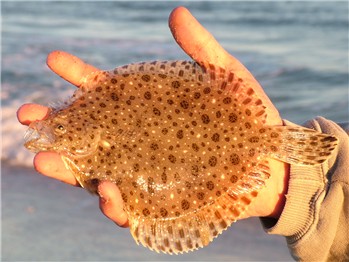|
Genus/Species
|
Scophthalmus aquosus
|
|
Common Names
|
sand dab, sundial, spotted flounder
|
|
Hot Spots
|
Green Harbor, Duxbury Bay, Scituate Harbor
|
|
Best Time
|
June-September
|
|
Best Baits
|
shrimp, squid strips, seaworms
|
|
Best Method
|
Bottom fishing with bait
|
DESCRIPTION :
Windowpane flounder can easily be confused as
malnourished, juvenile fluke or fourspot flounder. They are left-eyed like those fish but have a more
compressed body - more diamond shaped than oval. They are very thin flounders, similar to the fourspot, but
have numerous smaller spots on them and not the fewer larger spots of the fluke and fourspot. They also
have long pelvic and dorsal fin bases which extend toward their head. There is also one other feature, specifically
regarding the dorsal fin base that I find make them easy to distinguish from other flounders - there is no
membrane connecting the first few rays of the dorsal fin base by the head. Truly unique among the flounders
of the south shore. Younger windowpanes are so thin that they appear transparent on the underside, enabling
you to easily recognize the internal organs. This feature is how they got their name. It's mouth is relatively
large with tiny needle-like teeth. Caution should be used when handling this fish.
|

|
Easy to see how these flatfish get their name.
|
|
HABITS & HABITAT : |
Windowpane flounder live offshore at depths of 150 to 250 feet but move inshore in the summer following warming
water temperatures. They prefer sandy and mud bottoms in open areas, but can be also found near areas of structure.
Like fluke and fourspots, are more predator than scavenger. Their diet is less varied than those other, preferring
a steady diet of shrimp, however, they are known to consume worms, crabs, and small fish.
Windowpane range from Canada down to Florida but undergo seasonal migrations in the more northerly
and southerly reaches of this range. On the south shore of Massachusetts, they first
move into the region typically around mid-May, influenced by warming water temperatures. They seem
to exit sometime around November.
It is written that spawning takes place in spring just prior to the inshore migration. When spawning
has completed they begin to feed heavily. Larvae drift inshore where they mix with other varieties
of flatfish in protected coastal and estuarine areas.
|
|
FISHING FOR WINDOWPANE : |
I don't know if you could ever purposefully target windowpane, not that you would want to anywhay.
They are mostly caught as bycatch when fishing for fluke or other types of flounder. They are small
and skinny and offer little sport to the recreational fisherman. You can fish for windowpanes with
baits of seaworm, squid, or clam, however grass shrimp are probably the best baits. Since they
are predators as opposed to scavengers, I suppose it is within the realm of possibility that they
would take an artificial lure, however I have personally never seen or heard of this happening. The
best bait is live bait.
Due to it's small size, the windowpane is of very little importantance to the commercial or
recreational fishery. A tasty fish, however it nearly has to be a world record before it is big
enough to have any meat on it.
|

